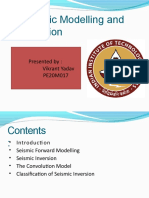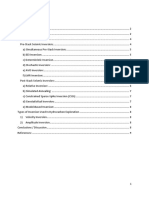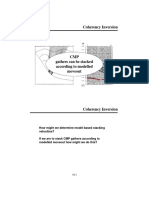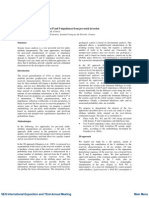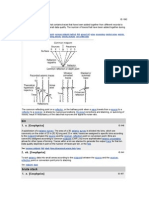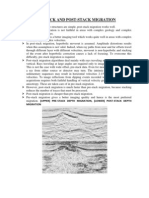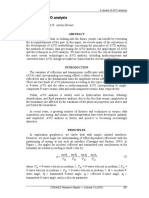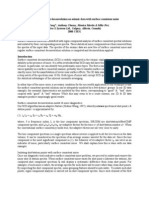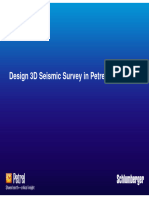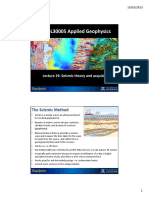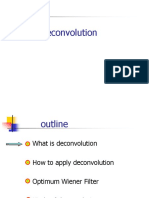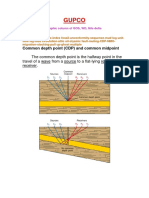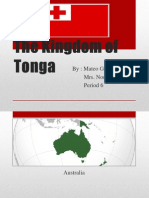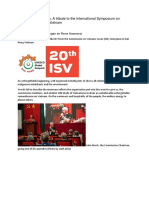Synthetic Seismogram PDF
Synthetic Seismogram PDF
Uploaded by
Omar MohammedCopyright:
Available Formats
Synthetic Seismogram PDF
Synthetic Seismogram PDF
Uploaded by
Omar MohammedOriginal Title
Copyright
Available Formats
Share this document
Did you find this document useful?
Is this content inappropriate?
Copyright:
Available Formats
Synthetic Seismogram PDF
Synthetic Seismogram PDF
Uploaded by
Omar MohammedCopyright:
Available Formats
Synthetic seismogram
University of Mosul, Collage of Petroleum Engineering and Mining
Reservoir Engineering Department
By Under Graduated Third Stage Student Omar Mohammed Qambar
May 29, 2020
T
he result of one of many forms of forward modeling to predict the seismic response of
the Earth. A more narrow definition used by seismic interpreters is that a synthetic seis-
mogram, commonly called a synthetic, is a direct one-dimensional model of acous-
tic energy traveling through the layers of the Earth. The synthetic seismogram is generated by
convolving the reflectivity derived from digitized acoustic and density logs with the wave-
let derived from seismic data. By comparing marker beds or other correlation points picked on
well logs with major reflections on the seismic section, interpretations of the data can be im-
proved. The quality of the match between a synthetic seismogram depends on well log quality,
seismic data processing quality, and the ability to extract a representative wavelet from seismic
data, among other factors. The acoustic log is generally calibrated with check-shot or vertical
seismic profile (VSP) first-arrival information before combining with the density log to pro-
duce acoustic impedance.
Keywords: check-shot survey, convolution, forward modeling, marker bed, multiple reflec-
tion, one-dimensional seismic data, phase, reflection, reflection coefficient, Ricker wave-
let, seismic modeling, seismic record, seismic section, shotpoint, trace, velocity, vertical seis-
mic profile, cloud-computing platform.
Introduction amount of computing resources. Conven-
tional high-performance computer clusters
T he synthetic seismogram is a theoreti-
cal seismic response model for as-
sumed geological situation. The final
may not provide a cost-effective solution to
this type of applications. The newly emerg-
ing cloud-computing platform provides an
product of our step-by-step procedure to alternative solution.
create a seismic model is a synthetic seis-
mogram or a synthetic seismic section. It applications
represents the idealize trace that should be
observed with the seismic method at the lo-
cation of the well. The use of edited or mod-
T he Synthetic Seismic trace can be
compared with the seismic trace actu-
ally measured at the well (calibration)
eled log data as input is highly recom-
to improve the picking of seismic horizons
mended. the primary well data required to
(relate horizon tops identified in a well with
generate a synthetic seismic trace are sonic
specific reflections on the seismic section),
log (inverse of the sonic log is the acoustic
and to improve the accuracy and resolution
velocity) and density log. Check shots data
of formations of interest, as shown in Fig.1.
from the well are also very important. Syn-
thetic seismograms generated by solving A synthetic seismogram tie at the well,
the seismic wave equation using numerical besides giving ideas about positioning of
methods are being widely used in seismol- well on ground and kind of reflections ex-
ogy. For fully three-dimensional seismic pected from the subsurface strata, it sheds
structure models, the generation of these light on the quality of the processed seismic
synthetic seismograms may require large
data. A good example of this is illustrated • We calculate the reflection coefficients at
in Fig.2. the step-changes in Impedance.
• We convolve our pulse with the RC series
to get individual wavelets.
• Each RC generates a wavelet whose am-
plitude is proportional to the RC.
• We sum the individual wavelets to get
the synthetic seismic trace.
This procedure is illustrated in fig.3
Fig.1 A synthetic seismogram workflow. Re-
flection coefficients computed from impedance
log is convolved with a wavelet to create syn-
thetic seismogram which is compared with seis-
mic for a match (Image: courtesy of Arcis Seis- Fig.3 illustrate synthetic seismogram model.
mic Solutions, TGS, Calgary)
Synthetic trace and its relationship
with the seismic sections and maps
T he synthetic seismogram is used to
pick the reflectors on the seismic sec-
tion, the procedure of picking is explained
bellow:
• After generate a synthetic seismogram
then calculate TWT for each layer from
the following equation:
𝑇𝑊𝑇 = 𝐷𝑒𝑝𝑡ℎ⁄𝑉𝑒𝑙𝑜𝑐𝑖𝑡𝑦
• From the calculated TWT different re-
flectors on synthetic seismogram were
picked.
Fig.2 Seismic calibration with CVL and syn-
• Then the synthetic seismogram is coin-
thetic seismogram. The seismic matches well
ciding with the seismic section.
except for the strong events at the center against
the shale section represented by flat CVL zone • Reference datum of synthetic to seismic
and no events in synthetic. Strong seismic data is usually the ground level or seismic
events are suspected multiples and entail repro- datum.
cessing (Image: courtesy of ONGC, India). • Accept the tie that yields best character
Generating a modeled trace tie with least time shift in the zone of in-
terest (reservoir).
T he procedure to generate a synthetic
seismic trace is:
• The reflectors will pick on this seismic
line and then on other lines using the in-
tersection points.
• we block the velocity (sonic) and density
logs and compute an impedance.
• Measurements of TWT were taken for
each reflector and on each seismic sec-
tion.
• The measurements of TWT for each re-
flector are plotted on the base of map of
the area for drawing isochrone map (time
map)
• From velocity analysis the average veloc-
ity map for each reflector is drawn also.
• Then by coinciding the velocity map over
isochron map the depth maps for each
layer are drawn.
References
1. Niranjan C. Nanda “Seismic data inter-
pretation and evaluation for hydrocar-
bon exploration and production”.
2. Oilfield Schlumberger Glossary, geo-
physical exploration department.
3. CRAIN'S Petrophysical Handbook.
4. KANSAS. GEOLOGICAL. SURVEY
“Synthetic Seismic Profile Plot “
5. James H. Leven “Physics of the Earth
and Planetary Interiors”
6. Enwenode Onajite “Seismic Data
Analysis Techniques in Hydrocarbon
Exploration (2014)”
You might also like
- Geo DepthDocument8 pagesGeo Depthcharef eddineNo ratings yet
- Pe20m017 Vikrantyadav Modelling and InversionDocument18 pagesPe20m017 Vikrantyadav Modelling and InversionNAGENDR_006No ratings yet
- Seismic InversionDocument9 pagesSeismic InversionMuhammad ArslanNo ratings yet
- 3-D Seismic Attributes: Dan Gr. Vetrici and Robert R. StewartDocument30 pages3-D Seismic Attributes: Dan Gr. Vetrici and Robert R. Stewartmichael2k7849100% (1)
- Coherency InversionDocument16 pagesCoherency InversionSani TipareNo ratings yet
- Depth Conversion of Time Interpretations Volume ModelsDocument53 pagesDepth Conversion of Time Interpretations Volume ModelsSani TipareNo ratings yet
- T Im E: Synthetic TraceDocument19 pagesT Im E: Synthetic TraceRAAJARSHE PRAKAASH GUPTANo ratings yet
- Theory of Seismic Imaging PDFDocument226 pagesTheory of Seismic Imaging PDFAngel Saldaña100% (1)
- Recent Advances in Nodal Land Seismic Acquisition SystemsDocument5 pagesRecent Advances in Nodal Land Seismic Acquisition SystemsHendro LaksonoNo ratings yet
- TG Structural Interpretation Ganjil 20-21Document79 pagesTG Structural Interpretation Ganjil 20-21andaruNo ratings yet
- What Kind of Vibroseis Deconvolution Is Used - Larry MewhortDocument4 pagesWhat Kind of Vibroseis Deconvolution Is Used - Larry MewhortBayu SaputroNo ratings yet
- Seismic Facies Analysis Applied To P and S Impedances From Pre-Stack InversionDocument4 pagesSeismic Facies Analysis Applied To P and S Impedances From Pre-Stack InversionMahmoud EloribiNo ratings yet
- Depth Conversion of Post Stack Seismic Migrated Horizon Map MigrationDocument11 pagesDepth Conversion of Post Stack Seismic Migrated Horizon Map MigrationhimanshugstNo ratings yet
- N. (Geophysics) : Seismic Record Noise FoldDocument84 pagesN. (Geophysics) : Seismic Record Noise FoldRazi AbbasNo ratings yet
- Phase - I Seismic Data Acquisition Phase - II Seismic Data Processing Phase - III Seismic Data InterpretationDocument27 pagesPhase - I Seismic Data Acquisition Phase - II Seismic Data Processing Phase - III Seismic Data InterpretationMajid AliNo ratings yet
- Pre-Stack and Post-Stack MigrationDocument4 pagesPre-Stack and Post-Stack MigrationMark MaoNo ratings yet
- A Review of AVO Analysis PDFDocument24 pagesA Review of AVO Analysis PDFMohamed Abdel-FattahNo ratings yet
- 2d 3d 4d Exploracion Sismica para Geologos CH Liner Conex - Mayo 1999Document388 pages2d 3d 4d Exploracion Sismica para Geologos CH Liner Conex - Mayo 1999Alfredo LastraNo ratings yet
- Amplitude Variation With Frequency As Direct Hydrocarbon Indicator For Quick Look and Different Insight of Hydrocarbon DelineationDocument7 pagesAmplitude Variation With Frequency As Direct Hydrocarbon Indicator For Quick Look and Different Insight of Hydrocarbon DelineationAwalNo ratings yet
- Lab 06 - Static CorrectionsDocument4 pagesLab 06 - Static Correctionsapi-323770220No ratings yet
- Surface Consistent Deconvolution On Seismic Data With Surface Consistent NoiseDocument5 pagesSurface Consistent Deconvolution On Seismic Data With Surface Consistent NoiseEduardo LugoNo ratings yet
- Practical Seismic Interpretation For Petroleum Exploration 1689090368Document119 pagesPractical Seismic Interpretation For Petroleum Exploration 1689090368Eduardo LeaubonNo ratings yet
- Basic ProcessingDocument86 pagesBasic ProcessingRazi AbbasNo ratings yet
- 3-D Seismic and Horizontal Wells - SEISMIC INTERPRETATION 31Document5 pages3-D Seismic and Horizontal Wells - SEISMIC INTERPRETATION 31380347467No ratings yet
- GEO ExPro - Geophysics - A Simple Guide To Seismic Amplitudes and DetuningDocument11 pagesGEO ExPro - Geophysics - A Simple Guide To Seismic Amplitudes and DetuningsolomonNo ratings yet
- SeismicDocument8 pagesSeismicAhmed Magdy BeshrNo ratings yet
- Seismic Amplitudes CorrectionDocument10 pagesSeismic Amplitudes Correctiontayofela100% (1)
- Why Spectral DecompositionDocument2 pagesWhy Spectral Decompositionanima1982No ratings yet
- 3D Seismic Facies Generated From Independent Seismic Attributes Using The Neural Network Technique - 6659949 - EDIT - 6659949 - 01Document9 pages3D Seismic Facies Generated From Independent Seismic Attributes Using The Neural Network Technique - 6659949 - EDIT - 6659949 - 01shkhawatNo ratings yet
- Stacking - in - Seismic - Processing (1) 111Document21 pagesStacking - in - Seismic - Processing (1) 111Kwame PeeNo ratings yet
- 3D Survey Design in Petrel - 6199334 - 03Document5 pages3D Survey Design in Petrel - 6199334 - 03shkhawatNo ratings yet
- Lecture-10 - Sesmic Data ProcessingDocument13 pagesLecture-10 - Sesmic Data ProcessingusjpphysicsNo ratings yet
- StartDocument1 pageStartwajdigeo216No ratings yet
- Pre Stack Migration Aperture - An Overview: Dr. J.V.S.S Narayana Murty, T. ShankarDocument6 pagesPre Stack Migration Aperture - An Overview: Dr. J.V.S.S Narayana Murty, T. ShankarJVSSNMurty100% (1)
- First Reflection Seismic Experiment in Oklahoma in 1921Document59 pagesFirst Reflection Seismic Experiment in Oklahoma in 1921Ezzadin BabanNo ratings yet
- GEOL30005 Applied Geophysics: The Seismic MethodDocument20 pagesGEOL30005 Applied Geophysics: The Seismic MethodMartin NguyenNo ratings yet
- Simple Seismics - For The Petroleum Geologist, The Reservoir Engineer, The Well-Log Analyst, The Processing Technician, and The Man in The Field 1982Document172 pagesSimple Seismics - For The Petroleum Geologist, The Reservoir Engineer, The Well-Log Analyst, The Processing Technician, and The Man in The Field 1982Stephen FortisNo ratings yet
- Seismic ReflectionDocument26 pagesSeismic ReflectionJeevan BabuNo ratings yet
- Residual Oil Saturation: The Information You Should Know About SeismicDocument9 pagesResidual Oil Saturation: The Information You Should Know About SeismicOnur AkturkNo ratings yet
- Predictive Deconvolution in Seismic Data Processing in Atala Prospect of Riversstate NigeriaDocument10 pagesPredictive Deconvolution in Seismic Data Processing in Atala Prospect of Riversstate NigeriaSajanNo ratings yet
- Lab 1 - Examine Seismic Data - QAB4083 - Seismic Data ProcessingDocument7 pagesLab 1 - Examine Seismic Data - QAB4083 - Seismic Data ProcessingfomNo ratings yet
- 6 Noise and Multiple Attenuation PDFDocument164 pages6 Noise and Multiple Attenuation PDFFelipe CorrêaNo ratings yet
- Dynamic CorrectionDocument18 pagesDynamic CorrectionMajid AliNo ratings yet
- 3 CoherenceDocument28 pages3 CoherenceSagnik Basu RoyNo ratings yet
- Seismic Attribute Genetic InversionDocument1 pageSeismic Attribute Genetic Inversionanima1982No ratings yet
- Carbonate Seismology (Geology Book)Document8 pagesCarbonate Seismology (Geology Book)RankurNo ratings yet
- Noise Attenuation Intmdt 03052018Document68 pagesNoise Attenuation Intmdt 03052018Pallav KumarNo ratings yet
- HowTo Analyse AnglesDocument5 pagesHowTo Analyse Anglesbidyut_iitkgpNo ratings yet
- 09 DeconvolutionDocument19 pages09 DeconvolutionPhạm NamNo ratings yet
- FB Tutorial Migration Imaging Conditions 141201Document11 pagesFB Tutorial Migration Imaging Conditions 141201Leonardo Octavio Olarte SánchezNo ratings yet
- Qualitative-Quantitative Seis Interp-TionDocument21 pagesQualitative-Quantitative Seis Interp-Tionnwankwovincent61No ratings yet
- Flex 3d DesignDocument16 pagesFlex 3d DesignBrajesh KumarNo ratings yet
- 2010 04 RECORDER Model Based Seismic InversionDocument12 pages2010 04 RECORDER Model Based Seismic Inversiondanjohhn0% (1)
- Gupco: Common Depth Point (CDP) and Common MidpointDocument3 pagesGupco: Common Depth Point (CDP) and Common MidpointmahmoudNo ratings yet
- DeconvolutionDocument19 pagesDeconvolutionSumanyu DixitNo ratings yet
- Well Logging Tools of Subsurface AnalysisDocument53 pagesWell Logging Tools of Subsurface Analysisroy sihalohoNo ratings yet
- 5 D Seismic ExplorationDocument66 pages5 D Seismic ExplorationAurum DatametrianaNo ratings yet
- Interbed Multiple AttenuationDocument5 pagesInterbed Multiple AttenuationRonald ChevalierNo ratings yet
- Carlos Planchart - 3D VSP in Lake Maracaibo, Venezuela PDFDocument5 pagesCarlos Planchart - 3D VSP in Lake Maracaibo, Venezuela PDFfranNo ratings yet
- Rivers and Floodplains: Forms, Processes, and Sedimentary RecordFrom EverandRivers and Floodplains: Forms, Processes, and Sedimentary RecordNo ratings yet
- Ground ImprovementDocument60 pagesGround ImprovementK.Sivanathan100% (1)
- The Kingdom of TongaDocument13 pagesThe Kingdom of Tongaapi-221683078No ratings yet
- Sample Paper 12 Class X Exam 2022-23 English-Language and LiteratureDocument13 pagesSample Paper 12 Class X Exam 2022-23 English-Language and Literatureeekshi0003No ratings yet
- Weather, Nature & EnvironmentDocument3 pagesWeather, Nature & EnvironmentMaripinkyNo ratings yet
- May 22Document12 pagesMay 22rossana rondaNo ratings yet
- The ISV20 Extension Publication Vietnam, C7Document6 pagesThe ISV20 Extension Publication Vietnam, C7Laurens SmetsNo ratings yet
- Ioesolutions Esign Com NP Contents Sanitary Engineering Ce 656Document5 pagesIoesolutions Esign Com NP Contents Sanitary Engineering Ce 656Ranjit MahatoNo ratings yet
- Bhanu Paperfor HydroDocument11 pagesBhanu Paperfor HydroAstrit E. SalihuNo ratings yet
- Comment On The Distribution of Fold MountainsDocument1 pageComment On The Distribution of Fold MountainsMary Davies100% (2)
- TutorialsDocument1 pageTutorialsHatim ShamsudinNo ratings yet
- Desal RGDocument168 pagesDesal RGrichu rasheedNo ratings yet
- Geol 454 Environmental and Exploration Geophysics I: Phone: 293-6431Document36 pagesGeol 454 Environmental and Exploration Geophysics I: Phone: 293-6431sukri arjuna100% (1)
- 100 Fantasy BiomesDocument2 pages100 Fantasy BiomesKane AleksanderNo ratings yet
- Exe Sum UMPP Eng PDFDocument32 pagesExe Sum UMPP Eng PDFFadi BoustanyNo ratings yet
- Msma CalculationDocument9 pagesMsma CalculationRaja Norazilla Raja YunusNo ratings yet
- Ladywell Fields End of Scheme ReportDocument41 pagesLadywell Fields End of Scheme Reportgofof55846No ratings yet
- TragedyofCommons ExperienceofRiverLinkinginKeralaDocument80 pagesTragedyofCommons ExperienceofRiverLinkinginKeralac_surendranathNo ratings yet
- Geophysical Mapping of Buried Faults in Parts of Bida Basin, North Central NigeriaDocument15 pagesGeophysical Mapping of Buried Faults in Parts of Bida Basin, North Central NigeriaMam MayssenNo ratings yet
- 50 WKNM 22Document105 pages50 WKNM 22Ismail ÜrerNo ratings yet
- Tisdell (2001)Document8 pagesTisdell (2001)Joaquín HernándezNo ratings yet
- Immediate Download Fundamentals of Ecology 5th Edition Odum Ebooks 2024Document77 pagesImmediate Download Fundamentals of Ecology 5th Edition Odum Ebooks 2024dmourgialloNo ratings yet
- Dixon 2010Document26 pagesDixon 2010AHMEDNo ratings yet
- Kaubolehhh CTDocument8 pagesKaubolehhh CTsarah nabilaNo ratings yet
- Magic of Minerals and RocksDocument161 pagesMagic of Minerals and RocksAlexandru Stefan100% (2)
- Ecg503 Week 4 Lecture Note Chp2Document66 pagesEcg503 Week 4 Lecture Note Chp2Muhammad Zulhusni Che RazaliNo ratings yet
- Dust Storm in ChinaDocument8 pagesDust Storm in ChinaShane GordonNo ratings yet
- Hyd FloodsDocument4 pagesHyd Floodsbalaji817150No ratings yet
- DRRR11 Q2 Mod7 Landslide-And-Sinkholes Version3Document17 pagesDRRR11 Q2 Mod7 Landslide-And-Sinkholes Version3Earl Caesar Quiba Pagunsan100% (1)
- Intelistrata: A System For Stratigraphic Interpretation of Well LogsDocument15 pagesIntelistrata: A System For Stratigraphic Interpretation of Well Logsc_b_umashankarNo ratings yet
- Meteorologist or Forecaster or Weather Forecaster or Energy ForeDocument3 pagesMeteorologist or Forecaster or Weather Forecaster or Energy Foreapi-77662946No ratings yet

